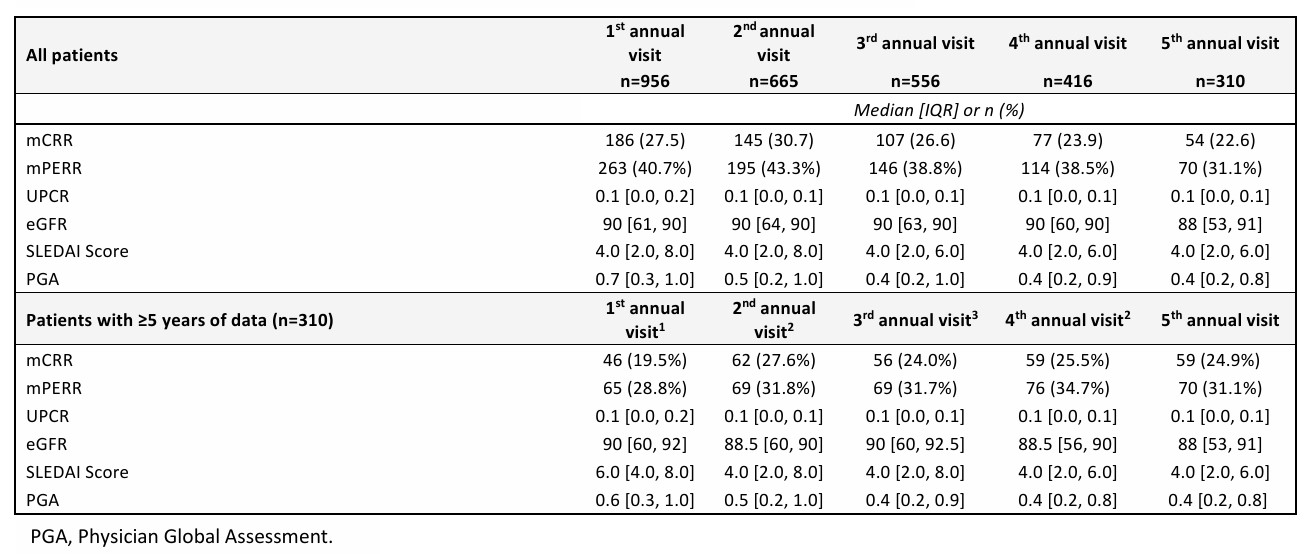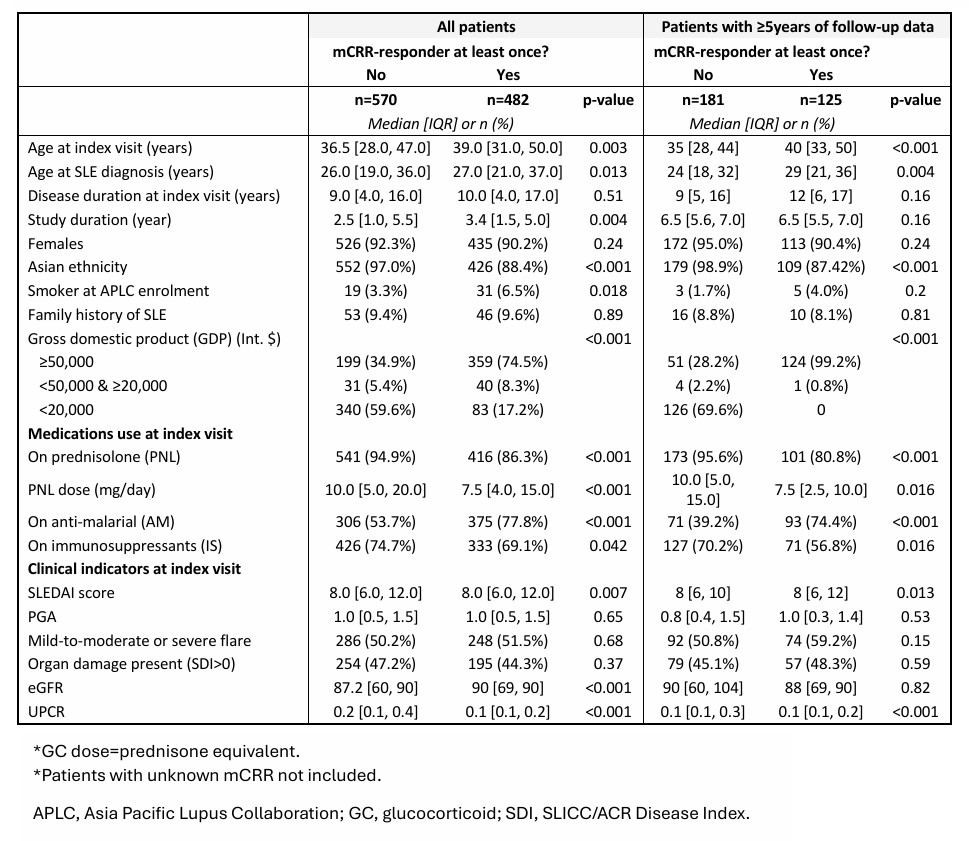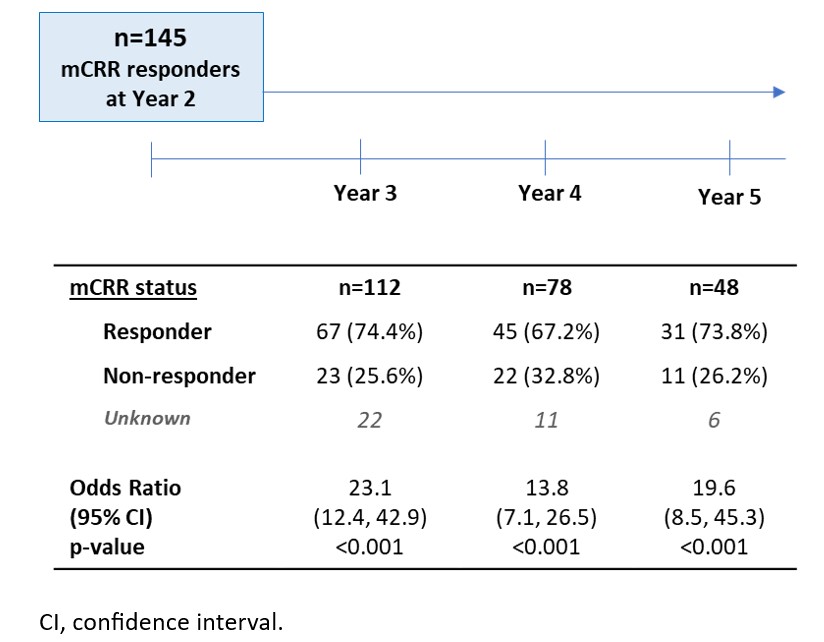Session Information
Session Type: Poster Session C
Session Time: 10:30AM-12:30PM
Background/Purpose: LN is prevalent in SLE, occurring in up to 50% of patients. Treatment response is evaluated by improvement in proteinuria and renal function, and achievement of remission is essential for better long-term outcomes. In clinical trials, only 30-40% of patients attain complete renal response (CRR) within 12 months of commencing immunosuppression. We assessed attainment of a modified definition of CRR (mCRR) in a large cohort of patients with SLE with active LN and compared patient characteristics between mCRR responders and non-responders.
Methods: Adult patients enrolled in a multinational observational cohort were studied prospectively from 2013 and 2020. Active LN was defined if patients had proteinuria defined by SLEDAI-2K criteria. The first visit with proteinuria during the observation period was defined as the index visit. Outcomes including mCRR (defined as urine protein creatinine ratio [uPCR] < 0.05 g/mmol and estimated glomerular filtration rate [eGFR] ≤10% below index value) and modified primary efficacy renal response (mPERR, defined as uPCR < 0.07 g/mmol and eGFR ≤20% below index value) were assessed annually over a 5-year period. Characteristics between mCRR responders and non-responders were compared using Wilcoxon rank-sum (numerical variables) and Chi-square (categorical variables) tests. The likelihood of mCRR attainment in subsequent years in patients who achieved mCRR at Year 2 was assessed using logistic regression analysis.
Results: In total, 1180 patients with active LN without exposure to biologics and with ≥2 visits (median [interquartile range, IQR] follow-up period: 2.7 years [1.0, 5.0]) were studied. Overall, 45.8% (482/1052) of patients attained mCRR at least once (mCRR responders) during the study period; the median (IQR) time to first mCRR attainment in mCRR responders was 6.2 (3.4, 12.9) months. mCRR was attained by 27.5% (186/956) at Year 1, 30.7% (145/665) at Year 2, and 22.6–26.6% at subsequent years. Of patients with ≥5 years of follow-up data (n=310), mCRR was attained by 19.5% (46/310) at Year 1, 27.6% (62/310) at Year 2, and 24.0–25.5% at subsequent years. (Table 1). Among those patients with ≥5 years follow up data, 40.8% (n=125/306) of this cohort attained mCRR responder status at least once. Compared with patients who never attained mCRR during 5-years of follow-up, mCRR responders were older, were less likely to be Asian, and almost all came from affluent countries with a gross domestic product exceeding Int. $50,000 (Table 2). mCRR responders at Year 2 had a significantly higher likelihood of mCRR attainment at subsequent years with odds ratios (95% confidence interval) at Years 3, 4, and 5 of 23.1 (12.4, 42.9), 13.8 (7.1, 26.5), and 19.6 (8.5, 45.3), respectively (Figure 1).
Conclusion: Almost half of this multinational study cohort with SLE and proteinuria attained mCRR after proteinuria was identified. mCRR attainment was highest at 2 years after proteinuria onset, and mCRR at Year 2 was associated with an increased likelihood of longer-term mCRR.
To cite this abstract in AMA style:
Ramnarain A, Xu X, Kent J, Jagtiani S, Louthrenoo W, Hamijoyo L, Luo S, Chen Y, Cho J, Chan C, Navarra S, Yao H, Pok L, Basnayake B, Zhang Z, Chan M, Bae S, Katsumata Y, Kikuchi J, O'Neill S, Goldblatt F, Poh Y, Sapsford M, Tugnet N, Ng K, Tee C, Tanaka Y, Nikpour M, Hoi A, Morand E, Kandane-Rathnayake R. Attainment of Complete Renal Response in Patients with Active Lupus Nephritis: A Multi-Center Cohort Study [abstract]. Arthritis Rheumatol. 2024; 76 (suppl 9). https://acrabstracts.org/abstract/attainment-of-complete-renal-response-in-patients-with-active-lupus-nephritis-a-multi-center-cohort-study/. Accessed .« Back to ACR Convergence 2024
ACR Meeting Abstracts - https://acrabstracts.org/abstract/attainment-of-complete-renal-response-in-patients-with-active-lupus-nephritis-a-multi-center-cohort-study/



